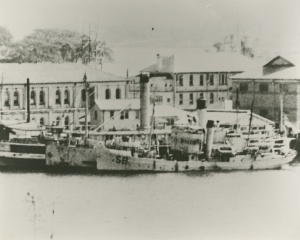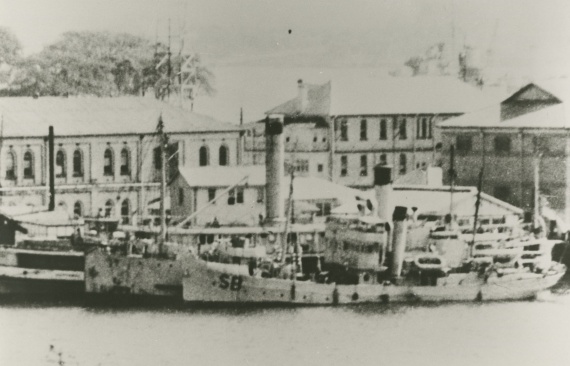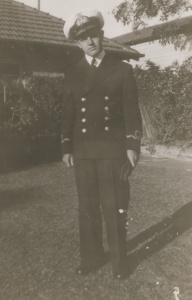HMAS Samuel Benbow
| Type |
Auxiliary Minesweeper |
|---|---|
| Builder |
Hall, Russell and Co Ltd, Aberdeen, Scotland |
| Commissioned |
5 September 1940 |
| Decommissioned |
1 November 1945 |
| Fate |
Resold to her former owners, 24 May 1946 |
| Dimensions & Displacement | |
| Displacement | 203 tons (gross) |
| Length | 115 feet 5 inches |
| Beam | 22 feet 1 inches |
| Draught | 12 feet 1 inches |
| Performance | |
| Speed | 8 knots |
| Complement | |
| Crew | 2 officers, 20 sailors |
| Armament | |
| Guns |
|
| Other Armament | Depth charges |
Throughout the course of World War II, the presence of enemy mines and submarines in Australian waters was of great concern to the Government and the Naval Board. On 30 June 1940, the auxiliary minesweeping groups in Australian waters comprised twelve ships based at Sydney, Melbourne, Fremantle, Brisbane and Newcastle. By the end of the year, this number was increased by a further seven ships and the establishment of a sixth minesweeping group in Darwin. Of the seven new ships, one was HMAS Bathurst (I), the first of the new Bathurst Class corvettes completed under the Government’s shipbuilding program. The other six were trawlers and coasters taken up from trade, one of which was the trawler, Samuel Benbow.
Samuel Benbow was built in Scotland in 1918 and operated in British waters until 1929 when she was brought to Sydney for Mr AA Murrell. She was sold on to Cam and Sons Pty Ltd in 1940. She was requisitioned for naval service on 4 August 1940. After fitting out as an auxiliary minesweeper she commissioned as HMAS Samuel Benbow at Sydney on 5 September 1940 under the command of Lieutenant Commander Keith M Levy, RANR. She was purchased outright on 29 June 1943.
She operated as a unit of Minesweeping Group 50, based at Sydney and was present during the Japanese midget submarine attack on the night of 31 May 1942. In the early hours of 1 June, HMA Ships Sea Mist, Yarroma and Steady Hour launched a concerted depth charge attack on a contact in Taylor Bay, and sunk Midget No. 21. The Japanese submarine lay at the bottom of Taylor Bay, her two man crew dead, her engines still running and her torpedoes jammed in her tubes. That evening, Samuel Benbow was moored to her by two 30 fathom lengths of 2½ inch wire. The following morning, 2 June, Samuel Benbow unsuccessfully attempted to drag her inshore. The submarine was later warped into shallow water by sheerlegs and slings, and salvaged.
Sub Lieutenant Bevan Mitchell, RANVR, recalls his brief posting to Samuel Benbow:
"The SB had been a trawler, steel hulled, and so was a good sea boat, excelling in rough weather. Designed to carry two officers, she offered me very basic accommodation, up forward in a bunk obviously intended for a deck hand...the First Lieutenant...was such a colourful character: a warrant officer, Bill Double hailed from somewhere in the north of England, or maybe Northern Ireland. What he didn’t know about seamanship was, to use the cliché, not worth knowing. In addition he commanded an extraordinary choice of words I’m sure had never been heard in the drawing room.
...we generally slipped at 7:00am, heading out to sea to commence the day’s sweeping - according to a pattern laid down for us in directions from the Port Minesweeping Officer...Normally we would carry on sweeping all day until nightfall, unless the weather became too foul for minesweeping to continue. When all was secured back at the wharf the usual practice was for one third of the ship’s company to be given shore leave, expiring at 6:00am, this being shortened now and then to midnight".
In September 1944 the ship proceeded to Thursday Island for employment on miscellaneous duties and spent the remainder of the war operating in Queensland waters. She was used as a survey vessel in 1945.
Samuel Benbow decommissioned at Sydney on 1 November 1945 and sold back to her former owners on 24 May 1946.





